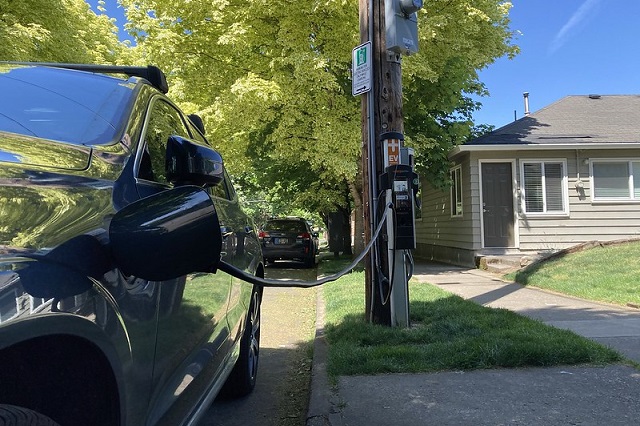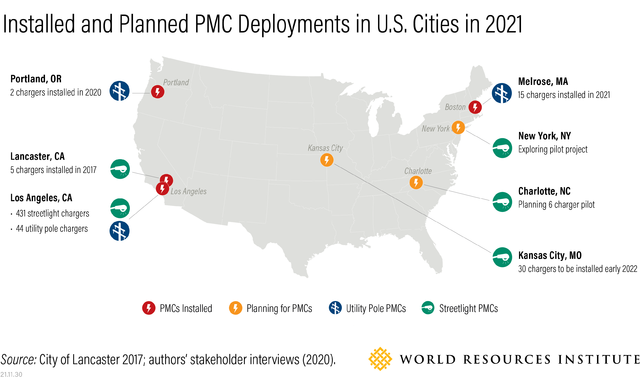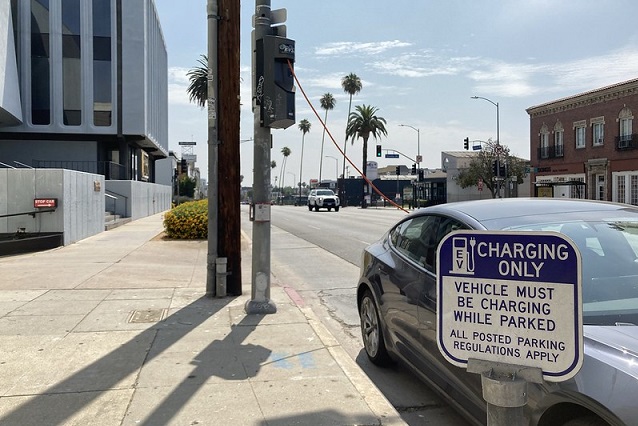
In August 2021, the Biden Administration and American automakers set a goal for electric vehicles (EVs) to make up 50% of new vehicle sales by 2030. In support of this goal, the recently enacted federal Infrastructure Investment Act allocates $7.5 billion for EV charging infrastructure. But for this monumental once-in-a-lifetime infrastructure buildout to be successful at enabling mass EV adoption, we need more public charging infrastructure that is more equitably distributed.
In California, which currently hosts the largest public charging network in the country, Black and Hispanic-majority communities, low-income populations, and residential areas with a greater number of multi-unit dwellings are least likely to have access to public charging. Similarly, more focus must be placed on reaching vehicle owners who do not have dedicated off-street parking or are unable to charge where they park.
Curbside charging stations can help improve access to EV charging. To advance the availability of curbside charging, cities will need to overcome specific barriers, including high costs and crowded curbsides. To navigate these challenges, a new approach has emerged that uses existing infrastructure, like utility poles and streetlights, to mount an EV charger: pole-mounted charging.
Gathering insights from over 30 stakeholders across 13 cities, a new WRI working paper funded by the UPS Foundation details learnings from existing pole-mounted charging programs and outlines preliminary guidance for U.S. cities and utilities interested in taking advantage of this low-cost, high-impact charging solution.
The Charger on Your Street
Pole-mounted chargers (PMCs) have experienced the most widespread and rapid deployment in Europe, most notably in London, which has over 3,500 PMCs on streetlights. Comparatively, only a handful of cities in the United States have successfully installed PMCs and only one, Los Angeles, has scaled it to a significant degree (over 400 chargers). One key distinction in the U.S. compared to Europe is the availability of electric utility poles. Many European countries have located their electrical distribution infrastructure underground.

Even with the limited number of deployments in the U.S., there are many reasons why more U.S. cities should consider utilizing the infrastructure already present on many streets to expand their charging networks.
1. Lower Costs, More Chargers
WRI’s research finds that compared to ground-mounted chargers, PMCs yield installation cost savings up to 55% and overall cost reductions of 30% by using existing electrical connections and avoiding costs associated with construction, materials and labor. This means more chargers can be deployed for the same amount of public and private investments, yielding a greater return on investment compared to other forms of public infrastructure. Public-private partnerships with electric utilities could also be advantageous, as they stand to gain from selling additional electricity through a more robust public charging network.
2. More Equitable Charger Distribution
Less than 10% of U.S. residents have access to charging within a quarter of a mile from home. Additionally, Black and Latinx communities have disproportionately less access to this infrastructure. With intentional planning, PMCs can help provide public charging access in areas that need it most, such as in communities that lack access to home charging or private garages. Local community engagement activities, like early public town halls, can help cities and utilities address concerns and build buy-in to improve utilization of the network. This has been a focal point of Kansas City’s PMC initiative, to understand the needs of residents and gather community feedback to be incorporated into PMC site selection.
3. Support Electrification of Shared Vehicles
Ride-hailing companies like Uber and Lyft have made commitments to completely electrify vehicles on their platforms in the U.S. by 2030. However, as WRI research shows, drivers are constrained from more widespread adoption of EVs by lack of access to charging infrastructure, especially those who reside in multifamily homes. Through PMC installations, ride-hailing companies can help inform charger siting and potentially help finance the network, potentially a win-win-win situation for cities, companies and drivers.
4. Efficient and Flexible Installations
Cities with PMCs have found that installation can be completed in a matter of hours, compared to the weeks it can take to install a ground-mounted unit. In addition, because PMCs are not anchored into the ground, they can be attached or detached from a pole with relative ease. If necessary, the equipment can be relocated to a different pole, making public chargers adaptable assets that can meet the ever-changing needs of the curbside, such as accommodating bike lanes and loading zones. Similarly, PMCs can help preserve valuable sidewalk space for pedestrians and other public services.
5. Elevated, Resilient Equipment
PMCs can be mounted several feet up on a pole, which can provide several benefits, including resilience in flood-prone areas, reducing vandalism, and keeping the charger and cords up and away from passing traffic and pedestrians, which could be a safety hazard.

6. Suitable Pole Capacity
PMCs depend heavily on the existing electrical capacity and voltage fed to the pole. Generally, utility poles tend to be better suited for PMCs in the U.S. for this reason. However, many cities are reducing electricity demand by replacing old streetlighting fixtures with efficient LEDs. The newly available capacity on a streetlight circuit can help enable PMC installations. Even without mounting PMCs, a streetlight’s preexisting connection can be used to supply electricity to micro-mobility charging docks, a strategy that has been implemented in Pittsburgh.
Looking Forward
Pole-mounted charging offers a cost-effective and creative approach for siting and installing public charging stations across more cities and in more neighborhoods.
Cities in Europe and a few in the United States have shown this solution works. At the same time, utility pole and streetlight infrastructure can vary significantly from one city to another, making it difficult to proclaim PMCs a one-size-fits-all solution. Using the guidance and insights developed by WRI, cities and utilities interested in deploying PMCs should assess if it is a strategy well-suited to their local context.
While PMC installations alone will not match the projected demand for public charging, they do present an important tool that can be an integral component of broader efforts to expand the availability of publicly accessible EV charging in U.S. cities.
For a more in-depth view of the potential for pole-mounted charging and stepwise guidance for those interested in implementing this solution, download our publication, “Pole-mounted Electric Vehicle Charging: Preliminary Guidance for a Low-Cost and More Accessible Public Charging Solution for U.S. Cities.”
Emmett Werthmann is a Research Analyst in Electric Mobility at WRI Ross Center for Sustainable Cities.
Vishant Kothari is Manager for Electric Vehicle-Grid Integration with the Global Electric Mobility team at WRI Ross Center for Sustainable Cities.






